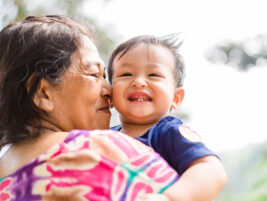
When we implemented Wittenberg’s Supporting Security Group program in our Infant Mental Health Unit, located in the Tel-Aviv area (Israel) and we started with training community health nurses and social workers, we asked one of the Israeli Arabic nurses what is the word for “Attachment” in Arabic…and she could not find any. Same happened with the Ethiopian social worker…My team and I were quite puzzled, and we thought these health workers don’t know about the concept of attachment because the professional literature in infant mental health has not been translated into Arabic nor into Amharic…The thought that attachment may not be relevant to their specific cultures (although they are part of the Israeli society) did not come through our “Western mind”, despite the bulk of papers that have been written on culture and infant mental health, the most recent being the IMHJ issue on Development of Infants and Toddlers in Ethnoracial Families (Fitzerald et al, 2009).
We had to realize that in fact, Ethiopian as well as Arabic infants tend to grow up within enlarged families, while all the grownups around them are caregivers, as opposed to the native Israeli Jewish infants who are raised in nuclear families.
Tronick’s (2007) recent publication draws new attention to a long standing issue in infant research, namely, the extent to which culture influences early development, and it broadens the conversation on culture, neurobiological and behavior organization, mental representations, and social-emotional regulatory processes that influence self-other relationships during the earliest years of life.
“Culture tailors the phylogenetically based aspects of caregiver investment strategies to the locally specific, relatively stable, social and physicalfeatures of the environment. Most importantly, culture helps define those features of the child’s behavior and communication that require attention and response, as well as the culturally appropriate form of the response” (Tronick, 2007, p. 99).
Specifically relating to attachment behaviors across cultures, the Efe people (in the Ituri rainforest in Congo) have adopted a strategy that mitigates against risk of infant’s survival, as well as against loss of parents, in the form of multiple nursing and caregiving. This practice enhances the infant’s ability to form trusting relationships with a variety of individuals, and probably impacts on the infant’s and adult caregivers’ brain. The Efe infant will show attachment behaviors to any individual in the group when distressed, as opposed to the Wwestern infant who is expected to turn only to their immediate caregiver. Another example is the Peruvian manta pouch, developed by the high-altitude living Quechua people: it is a tight wrapping system that provides a hospitable and portable microenvironment for the infant, warmer, more humid, lower in oxygen and higher in carbon dioxide. The higher level of CO2 enables the infant to sleep more, thus spending less energetics demands that can be used for growth and maintenance. On the other hand, the manta pouch restrains all the infant’s movements and keeps a low level of stimulation (baby’s face is covered by a blanket) and of social interchange. Instead of “diagnosing” this parental behavior as under stimulating and under involved, one should remember the specific context of the Quechua people: at the age of 6-7 years, children are expected to care the herd, a highresponsibility task that requires high degrees of vigilance, low curiosity and exploratory behavior, and an ability to tolerate a lack of social interchange…a totally different context from the 6 years old Western child’s… A last example is about the Gusii culture in Kenya: display of intense affects is to be avoided, as a potentially disruptive force. The face-to-face situation may call up strong feelings, therefore needs to be particularly regulated. A typical adultadult interaction often occurs with completely averted eye gaze (which, in our Western culture, is seen as a violation of mutual trust and arouses suspicion of malintent or insincerity). Greeting behavior is also strictly governed by rules. The analysis of face-to-face interactions (Tronick, 2007), has shown that Gusii motherinfant relationships are characterized by avoidance of eye-to-eye contact, restraint in playful interactions, rare affectionate and social behaviors toward the baby (who is perceived not capable of communicative intent other than hunger or distress), and almost no talking to infants, nor response to infant’s vocalizations (again because lack of giving interactive meaning to it), but only to cries (It is silly to talk to a baby” a Gusii mother said). Enhancing social development or cognitive growth are not part of the mother’s culture-specific parental goals, and Gusii children are much less attention-seeking than infants from other cultures.
In sum, while we assess parent-infant interactions, we must know what is the profile of the best fitted individual to the specific cultural group they belong to: the interactions of mother and infant can be seen as uniquely suited to the cultural goals and expectations. Overlooking it may lead to false diagnoses and irrelevant interventions.
References
Fitzgerald, H.E., Mann, T., Cabrera, N., Sarche, M. & Qin, D. (2009). Development of Infants and Toddlers in Ethnoracial Families. Infant Mental Health Journal, 30 (5).
Tronick, E. (2007). The neurobehavioral and Social Emotional Development of Infants and Children. New York; The Norton Press, pp.97-152.
Authors
Keren, Miri,
the Editor of Signal,
Israel








